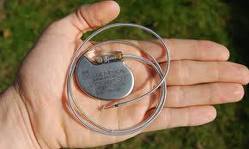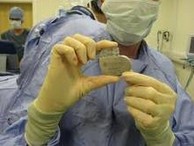Used Pacemakers Help Poor Heart Patients 心脏起搏器的“第二次生命”
慢速英语
 A pacemaker is a small device that doctors place in people with an abnormal heartbeat. If a heart beats too slowly the pacemaker will use electrical signals to help set a normal rate. Some devices include a defibrillator[(电击)除颤器] which gives a shock if the heart beats too fast. Pacemakers may be permanent or temporary, but one thing is sure: developing countries need more of them as more people get heart disease. A big problem, however, is the cost. Buying and implanting a pacemaker costs from 5,000 to 15,000 dollars.
A pacemaker is a small device that doctors place in people with an abnormal heartbeat. If a heart beats too slowly the pacemaker will use electrical signals to help set a normal rate. Some devices include a defibrillator[(电击)除颤器] which gives a shock if the heart beats too fast. Pacemakers may be permanent or temporary, but one thing is sure: developing countries need more of them as more people get heart disease. A big problem, however, is the cost. Buying and implanting a pacemaker costs from 5,000 to 15,000 dollars.
But doctors at the University of Michigan think they know a way to lower that cost. The idea is to reuse pacemakers. Heart doctor Timir Baman estimates that more than one million people worldwide need pacemakers each year. He says reusing a pacemaker is an ethical[合乎道德的] way to provide health care to those who have no other way to get one.
Baman: A country such as Bangladesh or India, they average less than eight new implants per million, and the United States we average 752 new implants per million.
He got the idea a few years ago. One of his patients asked if someone might be given her pacemaker for reuse after she died. But are used pacemakers safe? Doctor Baman studied medical reports about the safety of pacemakers that were being reused in small studies.
Funeral directors normally remove pacemakers when preparing bodies for cremation[火葬]. Pacemakers can explode if they are burned. So Doctor Baman asked funeral directors in Michigan to send the pacemakers to him. He and other researchers at the University of Michigan Medical Center tested the used pacemakers. They cleaned and disinfected[给……消毒] the ones in good working order. Then they sent them to doctors in the
Philippines, Vietnam, and Ghana. The doctors successfully implanted the used pacemakers in 12 patients.
Baman: If we show that this is safe, other academic centers in the United States, as well as in Europe, can then form their own pacemaker reutilization programs and really help out countries in Africa, really help out countries in Asia, who really have no other access[通道] to this type of devices.
The findings were recently presented at a conference in Washington of the American Heart Association. Now Timir Baman has asked the United States Food and Drug Administration for approval to do a larger test. He says that he is hopeful the program will work.
 起搏器是医生在心率不正常的人身上安置的一个小装置。如果心脏跳动过慢,起搏器就会通过电子信号帮助心脏重拾正常频率。另外一些设备包含除颤器,它会在心脏跳动过快时进行电击。起搏器既有永久使用型,也有短时安装型,但是有一点可以确定:发展中国家有越来越多人患上心脏病,起搏器的需求量越来越大。然而,费用问题相当棘手。购买和植入一个起搏器需要5000至15000美元。
起搏器是医生在心率不正常的人身上安置的一个小装置。如果心脏跳动过慢,起搏器就会通过电子信号帮助心脏重拾正常频率。另外一些设备包含除颤器,它会在心脏跳动过快时进行电击。起搏器既有永久使用型,也有短时安装型,但是有一点可以确定:发展中国家有越来越多人患上心脏病,起搏器的需求量越来越大。然而,费用问题相当棘手。购买和植入一个起搏器需要5000至15000美元。
然而(美国)密歇根大学的医生找到了一个降低成本的方法——重复使用起搏器。心脏科医生提米尔·巴曼估计,全世界每年有超过一百万人需要起搏器。他认为重复使用起搏器是一种既符合伦理道德,又可以为那些没有其他获取途径的人提供医疗保健的方法。
巴曼:例如在孟加拉或者印度这样的国家,一百万人里只有平均不到八例的新植入病例。而在美国,平均一百万人里就有752例新植入病例。
他几年前就有了这个想法。他的一名病人曾经问道,在她去世后,可否将她的起搏器给别人重复使用。但使用过的起搏器是否安全呢?巴曼医生研读了多份关于起搏器重复使用的安全问题的小型医学研究报告。
在准备火葬时,丧葬承办人一般会将遗体内的起搏器移除。(因为)起搏器可能会在焚烧过程中发生爆炸。因此,巴曼医生请求密歇根州的丧葬承办人把这些起搏器给他。他和密歇根大学医学中心的其他研究人员对这些起搏器进行检测。他们对那些还能正常运作的起搏器进行了清洁和消毒,然后将这些起搏器送给菲律宾、越南和加纳的医生。那里的医生成功将这些“二手”起搏器植入到12位病人体内。
巴曼:如果我们能够证明这是安全的,那么美国——甚至欧洲的其他学术中心便能开展他们的起搏器回收再用项目,这能真正帮助到非洲国家、亚洲国家那些确实没有其他途径获得这些设备的人。
医生们将这项发现在最近一场美国心脏协会华盛顿会议上进行了展示。现在,提米尔·巴曼已经向美国食品和药物管理局提出申请,以进行大范围试验。他希望这个计划能够成功。
